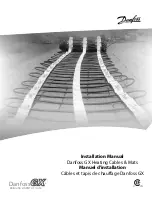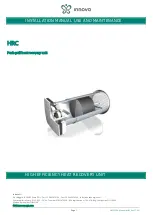
B)
Drill 3/16” hole at the desired location. To prevent
shock hazard, use a battery operated drill.
C)
Turn valve handle clockwise to expose piercing
lance beyond the rubber gasket no more than 3/16”.
D)
Assemble saddle valve on the supply pipe by
screwing the two halves together. Use the “V” side
of the bracket. Tighten screws evenly and firmly,
keeping the two sides of the bracket parallel.
E)
Turn saddle valve handle clockwise to close
valve. With a wrench, tighten nut/seal around stem.
F)
When you wish to open valve and supply cold
water to the unit, turn valve handle counterclockwise.
G)
Connect appropriate length of 1/4” tubing to the
feed water valve, using brass compression nut,
insert, and plastic sleeve. See diagram.
NOTE:
For basement installations, a longer length
of orange feed water tubing may have to be used.
E. Prefill And Sanitize The Storage Tank
Prefilling the tank is always recommended so there
is pressure to check for leaks and several gallons of
water to flush carbon post filter. Tanks are furnished
with a special disinfection capsule which sanitizes
the tank when it is filled with water. An instruction
tag will accompany the tank. It is important to use a
sanitizer when prefilling the tank so the solution can
sanitize the tubing, fittings, and faucet at the time of
installation and startups.
A)
Insert free end of orange feed water tubing into
the “Push In” fitting on the storage tank.
B)
Open feed water valve and tank and allow to fill
(about 3 minutes).
C)
Turn off feed water valve and tank valve and set
tank aside (15 minutes minimum).
NOTE:
If an alternative storage tank is used without
a disinfection capsule, it should be sanitized with
household bleach (5.25%). Use 1 ml bleach per gal-
lon of tank capacity.
F. Install The Drain Connection (fig.4)
For Basement Installations See page 8
Undercounter Installations:
IMPORTANT: Before starting this procedure,
inspect the condition of the drain piping, espe-
cially in older homes where the traps and tail-
pieces can be deceptively thin and frail. If in
poor condition, it is wise to inform the customer
that the condition should be remedied.
IMPORTANT: Some local plumbing codes may
prohibit the use of saddle-type drain connec-
tions. See page 11 for further information.
The drain saddle assembly is designed to fit
around a standard 1-1/2” O.D. drain pipe. For small-
er (lavatory type) or larger (ABS pipe) drains, con-
sult the factory for special drain saddles.
The drain saddles should always be installed
above (before) the trap and on the vertical or horizontal
tailpiece. Never install the drain saddle close to the
out- let of a garbage disposal or plugging of the RO
drain line may occur.
A)
Position threaded half of drain saddle at selected
location and mark the spot through the opening.
B)
Drill a 1/4” hole at the marked spot through one
side of drain tailpiece.
C)
Position both halves of drain saddle on drain pipe
so threaded opening lines up with the hole in drain
pipe.
D)
Use bolts and nuts to clamp drain saddle onto
drain pipe. Do not over tighten and make sure there
is equal space between saddle halves on each side.
E)
Wrap Teflon
®
tape on thread of drain saddle
elbow and tighten into drain saddle. Orient elbow in
the direction of RO faucet location.
G. Install The Faucet (Fig.5)
Undercounter installations generally require that the
faucet is installed with the air gap module. In base-
ment installations, the air gap module can be elimi-
nated only if one is provided elsewhere in the drain
line.
IMPORTANT: The Uniform Plumbing Code dic-
tates that there must be an air gap between the
RO line and the waste drain.
NOTE:
An optional non-air gap faucet, which
requires a smaller (9/16”) hole, is available from the
factory to make basement installations easier.
A wide variety of RO faucet mounting situa-
tions can be encountered, the most common being
stainless steel and ceramic on metal sinks. Consult
the factory for other materials encountered.
4
Teflon is a registered trademark of E.I. Dupont.

































